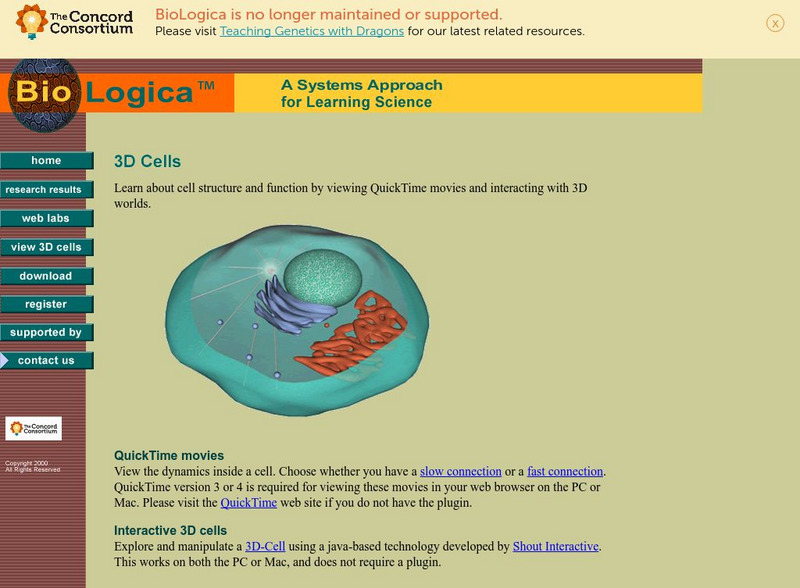Concord Consortium
The Concord Consortium: Why Don't Oil and Water Mix?
In this learning module from The Concord Consortium, students will explore how energy and electric forces change when you mix polar and non-polar substances together.
Concord Consortium
The Concord Consortium: Can a Substance Dissolve in Both a Nonpolar and a Polar Liquid?
In this learning module from The Concord Consortium, students will investigate how polar and non-polar regions in big molecules interact to result in certain shapes and properties for those molecules.
Concord Consortium
The Concord Consortium: What Are Proteins and How Do They Fold Into Biologically Important Shapes?
In this learning module from The Concord Consortium, students will investigate how polar and nonpolar regions in big molecules interact to result in certain shapes and properties for those molecules.
Concord Consortium
The Concord Consortium: Antibody and Antigen Interactive Lab
In this learning module from The Concord Consortium, students will explore how the shape of the antibody is complementary to the shape of the antigen.
Concord Consortium
Concord Consortium: Stem Resources: Making Heat
In this activity, students perform a reaction with different concentrations of reactants and monitor the temperature of the reaction. Activity contains procedure, analysis questions, and graph template. Students can save their answers...
Concord Consortium
3 D Cells
A brief animation and a more detailed navigation of a cell and it's structure can be found here. Each part is labeled and some are animated.
Concord Consortium
The Concord Consortium: Molecular Workbench: Newton's Cradle
Adjust the mass of one of the balls to see how the other objects are affected in the animated Newton's Cradle.
Concord Consortium
The Concord Consortium: Molecular Workbench: Mass Hung on a Spring
Experiment to see how air resistance affects the periodic motion of a mass on a spring.
Concord Consortium
The Concord Consortium: Molecular Workbench: Mass Connected to 2 Springs
Observe how friction affects a mass connected to two springs that are on opposite sides of the mass. Create a graph while the friction is on or off.
Concord Consortium
The Concord Consortium: Molecular Workbench: Forces and Systems
See how motion is converted and the energy associated with the motion is used to do work.
Concord Consortium
The Concord Consortium: Molecular Workbench: Motion Conversion
View the conversion of linear motion to rotational motion.
Concord Consortium
The Concord Consortium: Molecular Workbench: Pendulum, Slider, and Spring
Observe the motion of this animated system to represent an analogy for molecular mechanics of atoms and molecules.
Concord Consortium
The Concord Consortium: Molecular Workbench: A Suspended Rope
Adjust the elasticity and mass of a rope suspended between two points to see how it will be affected by gravity.
Concord Consortium
The Concord Consortium: Molecular Workbench: Weight Balance on a Pulley
Watch how the placement of two weights attached to a chain on different sides of a pulley affect the movement of the system. You can adjust the heaviness of the weights.
Concord Consortium
The Concord Consortium: Molecular Workbench: Bunimovich Stadium
Watch as two particles move through a confined area. The emphasis is on their motion in a straight line until they encounter a barrier and are reflected off in a different direction.
Concord Consortium
The Concord Consortium: Molecular Workbench: Linkages
View several examples demonstrating that rotational motion may be transformed into straight-line motion.
Concord Consortium
The Concord Consortium: Molecular Workbench: Conservation of Momentum
View a simulation that shows the reaction to a cart on wheels carrying a swinging pendulum.
Concord Consortium
The Concord Consortium: Molecular Workbench: Friction and Movement
Explore how friction between a surface and tires affects the movement of a bicycle.
Concord Consortium
Concord Consortium: Molecular Workbench: Convert Rotational Movement to Waves
View a simulation that converts rotational motion into waves.
Concord Consortium
The Concord Consortium: Molecular Workbench: Overshot Water Wheel
View a simulation of water moving over the top of a water wheel and causing it to move demonstrating the conversion of energy.
Concord Consortium
The Concord Consortium: Molecular Workbench: Undershot Water Wheel
View a simulation of water flowing under a wheel that causes the wheel to rotate. Energy from the water is transferred to the wheel.
Concord Consortium
The Concord Consortium: Molecular Workbench: Nodding Donkey (Pump Jack)
View a simulation of the mechanics that make an oil pump do its job.
Concord Consortium
The Concord Consortium: Molecular Workbench: Cycloid
View the example that shows how a cycloid is created.
Concord Consortium
The Concord Consortium: Molecular Workbench: Hypocycloid
View a hypocycloid being created in this simulation.






















